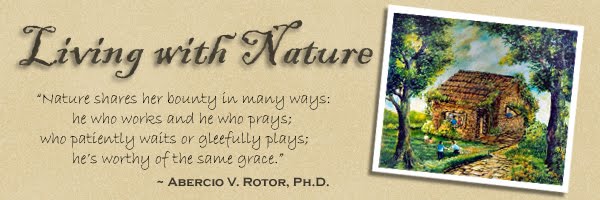Trees for Peace
Saga and Fate of Three Trees
Three big trees growing together reached the prime of their lives. They belong to different species and families but fate brought them to one place.
Three Trees in acrylic by AVR
· One is the biggest legume of earth. Leguminous plants are known for their high food value.
The second is the source of the best wood on earth, sending the oak to the back seat.
The third has the most popular medicine for common ailments in the world, especially colds.
How lucky we are! They said in a chorus, singing with the passing wind and chirping of birds and sound of busy feet below and around them.
For half a century or so, they stood through seasons and events, in favorable weather and force majeure. They have many common things they share to humans and the environment. They …
Provide shade to passersby
· Cool the surroundings day and night· Buffer loud noise and unpleasant sound
· Tame strong wind into breeze
· Catch the rain and store it in the ground
· Filter dusts and particulates
· Shields radiation from sun and space, fallout and radioactive materials
· Capture low-lying clouds with the water vapor they transpire causing it to fall as rain
· Condense fog and mist into dewdrops
· Provide food and shelter to many organisms
· Produce Oxygen, byproduct of photosynthesis
· Fertilize the soil, make litter of compost
· Provide a wildlife sanctuary
· Create artistic theme and subject
· Harbor in the imagination myths and legends
Individually, they started comparing themselves. Well, self-centeredness is a not only among humans, but trees and other organisms as well. The Acacia (Samanea saman) was the first to talk about itself. It…
· Harbors Rhizobium bacteria in its roots that convert Nitrogen into Nitrate
· Nitrate makes it self-fertilizing, and benefactor of this life-giving substance
to other plants
· Being deciduous, forms a litter of leaves to become compost and food
· Being deciduous, forms a litter of leaves to become compost and food
of decomposers
· Produces sugar-rich pods for goats and other animals
· Blooms in summer and breaks the dull and dry view of the landscape
· Provides home to many tenant organisms, and inn to transient one
· Harbors on its spongy limbs orchids, ferns, lichen and mosses
· Produces materials for many kinds of wooden crafts
· Is used by the faithful on Lenten Season in preparing the stations of the cross.
· Has a majestic baroque profile, singly or collectively few trees can match
· Forms whole forest called Dipterocarp Forest, adopted from its
· Produces sugar-rich pods for goats and other animals
· Blooms in summer and breaks the dull and dry view of the landscape
· Provides home to many tenant organisms, and inn to transient one
· Harbors on its spongy limbs orchids, ferns, lichen and mosses
· Produces materials for many kinds of wooden crafts
· Is used by the faithful on Lenten Season in preparing the stations of the cross.
The Narra (Pterocarpus indicus) talked with a sense of pride being the country’s national tree. It is indigenous, unlike the acacia whose origin is Mexico, and the Eucalyptus from Australia where the Koala Bear resides. It…
· Has a majestic baroque profile, singly or collectively few trees can match
· Forms whole forest called Dipterocarp Forest, adopted from its
family Dipterocarpaceae
· Gives the best wood in the world for furniture, construction and wood crafts
· Has a substance in its bark that cures diabetes and other diseases
· Blooms profusely in summer with golden flowers falling into confetti with the wind
· Gives a feeling of affluence to owners of finished products from its wood
· Is the most protected by law, but still carries the old fear that destroyed its.
· Gives the best wood in the world for furniture, construction and wood crafts
· Has a substance in its bark that cures diabetes and other diseases
· Blooms profusely in summer with golden flowers falling into confetti with the wind
· Gives a feeling of affluence to owners of finished products from its wood
· Is the most protected by law, but still carries the old fear that destroyed its.
forebears and kin

Century-old acacia, Tagudin, Ilocos Sur
The Eucalyptus (common and genus name) may look lanky and frail with flimsy crown, but is an Eiffel tower to most trees. Its branches droop like on a cloth line, and sway with the wind in cantabile. It …
· Produces in its leaves volatile oil rich in menthol
· Fills in the immediate surroundings with pleasant
· Fills in the immediate surroundings with pleasant
fresh smell
· Is Nature’s aroma therapy, it serves as bronco-
· Is Nature’s aroma therapy, it serves as bronco-
dilator
· Wakes up the unconscious, relieves vertigo
· Drives away flies and mosquitoes
· Smudges fruit trees, inducing them to flower and set fruits
· Home to the Koala and other organisms
· Provides good lumber for construction and furniture
· Wakes up the unconscious, relieves vertigo
· Drives away flies and mosquitoes
· Smudges fruit trees, inducing them to flower and set fruits
· Home to the Koala and other organisms
· Provides good lumber for construction and furniture
So the three trees continued to live on for many more years. They could reach a hundred years. Their relatives in the forest could live longer. Soon they grew so big they became apple (and gold) to the eye of the logger.
Just as they feared, the fearsome chainsaw broke the still morning air. ~


No comments:
Post a Comment